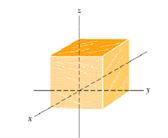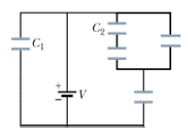Assignment:
Question 1. At each point on the surface of the cube shown in Figure, the electric field is parallel to z-axis. The length of each edge of the cube is 3.0 m. On the top face of the cube, E = -34k N/C, and at the bottom face E = +20k N/C. Determine the net charge contained within the cube.

Question 2. A long, straight wire has fixed negative charge with a linear charge density of magnitude of 3.6 nC/m. The wire is to be enclosed by a coaxial, thin walled nonconducting cylindrical shell of radius 1.5 cm. The shell is to have positive charge on its outside surface with a surface charge density sigma that makes the net external electric field zero. Calculate sigma.
Question 3. A nonconducting sphere has radius R = 2.31 cm and uniformly distributed charge q = + 3.50 fC. Take the electric potential at the sphere's center to be V0 = 0. What is V at radial distance (a) r = 1.45 cm, and (b) r = R.
Question 4. A hollow metal sphere has a potential of +400 V with respect to ground (defined to be at V = 0) and a charge of 5.0 * 10^(-9) C. Find the electric potential at the center of the sphere.
Question 5. The battery has a potential difference of V = 10.0 V and five capacitors each have a capacitance of 10.0 uF. What is the charge on (a) capacitor 1 and (b) capacitor 2?
